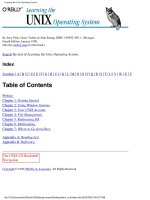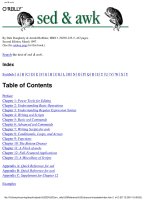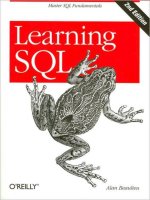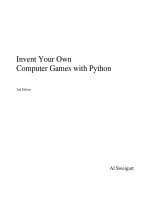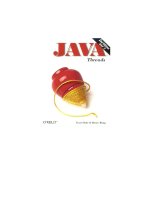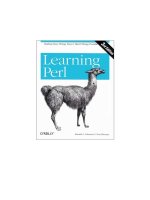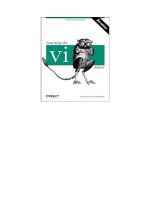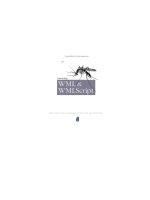o'reilly - learning python 2nd edition
Bạn đang xem bản rút gọn của tài liệu. Xem và tải ngay bản đầy đủ của tài liệu tại đây (5.81 MB, 640 trang )
[ Team LiB ]
• Table of Contents
• Index
• Reviews
• Reader Reviews
• Errata
• Academic
Learning Python, 2nd Edition
By David Ascher, Mark Lutz
Publisher: O'Reilly
Pub Date: December 2003
ISBN: 0-596-00281-5
Pages: 620
Learning Python, Second Edition offers programmers a comprehensive learning tool for Python and object-oriented programming.
Thoroughly updated, this guide introduces the basic elements of the latest release of Python 2.3 and covers new features, such as list
comprehensions, nested scopes, and iterators/generators.
[ Team LiB ]
[ Team LiB ]
• Table of Contents
• Index
• Reviews
• Reader Reviews
• Errata
• Academic
Learning Python, 2nd Edition
By David Ascher, Mark Lutz
Publisher: O'Reilly
Pub Date: December 2003
ISBN: 0-596-00281-5
Pages: 620
Copyright
Dedication
Preface
About This Second Edition
Prerequisites
This Book's Scope
This Book's Style and Structure
Book Updates
Font Conventions
About the Programs in This Book
Using Code Examples
How to Contact Us
Acknowledgments
Part I: Getting Started
Chapter 1. A Python Q&A Session
Section 1.1. Why Do People Use Python?
Section 1.2. Is Python a Scripting Language?
Section 1.3. Okay, But What's the Downside?
Section 1.4. Who Uses Python Today?
Section 1.5. What Can I Do with Python?
Section 1.6. What Are Python's Technical Strengths?
Section 1.7. How Does Python Stack Up to Language X?
Chapter 2. How Python Runs Programs
Section 2.1. Introducing the Python Interpreter
Section 2.2. Program Execution
Section 2.3. Execution Model Variations
Chapter 3. How You Run Programs
Section 3.1. Interactive Coding
Section 3.2. System Command Lines and Files
Section 3.3. Clicking Windows File Icons
Section 3.4. Module Imports and Reloads
Section 3.5. The IDLE User Interface
Section 3.6. Other IDEs
Section 3.7. Embedding Calls
Section 3.8. Frozen Binary Executables
Section 3.9. Text Editor Launch Options
Section 3.10. Other Launch Options
Section 3.11. Future Possibilities?
Section 3.12. Which Option Should I Use?
Section 3.13. Part I Exercises
Part II: Types and Operations
Chapter 4. Numbers
Section 4.1. Python Program Structure
Section 4.2. Why Use Built-in Types?
Section 4.3. Numbers
Section 4.4. Python Expression Operators
Section 4.5. Numbers in Action
Section 4.6. The Dynamic Typing Interlude
Chapter 5. Strings
Section 5.1. String Literals
Section 5.2. Strings in Action
Section 5.3. String Formatting
Section 5.4. String Methods
Section 5.5. General Type Categories
Chapter 6. Lists and Dictionaries
Section 6.1. Lists
Section 6.2. Lists in Action
Section 6.3. Dictionaries
Section 6.4. Dictionaries in Action
Chapter 7. Tuples, Files, and Everything Else
Section 7.1. Tuples
Section 7.2. Files
Section 7.3. Type Categories Revisited
Section 7.4. Object Generality
Section 7.5. References Versus Copies
Section 7.6. Comparisons, Equality, and Truth
Section 7.7. Python's Type Hierarchies
Section 7.8. Other Types in Python
Section 7.9. Built-in Type Gotchas
Section 7.10. Part II Exercises
Part III: Statements and Syntax
Chapter 8. Assignment, Expressions, and Print
Section 8.1. Assignment Statements
Section 8.2. Expression Statements
Section 8.3. Print Statements
Chapter 9. if Tests
Section 9.1. if Statements
Section 9.2. Python Syntax Rules
Section 9.3. Truth Tests
Chapter 10. while and for Loops
Section 10.1. while Loops
Section 10.2. break, continue, pass, and the Loop else
Section 10.3. for Loops
Section 10.4. Loop Variations
Chapter 11. Documenting Python Code
Section 11.1. The Python Documentation Interlude
Section 11.2. Common Coding Gotchas
Section 11.3. Part III Exercises
Part IV: Functions
Chapter 12. Function Basics
Section 12.1. Why Use Functions?
Section 12.2. Coding Functions
Section 12.3. A First Example: Definitions and Calls
Section 12.4. A Second Example: Intersecting Sequences
Chapter 13. Scopes and Arguments
Section 13.1. Scope Rules
Section 13.2. The global Statement
Section 13.3. Scopes and Nested Functions
Section 13.4. Passing Arguments
Section 13.5. Special Argument Matching Modes
Chapter 14. Advanced Function Topics
Section 14.1. Anonymous Functions: lambda
Section 14.2. Applying Functions to Arguments
Section 14.3. Mapping Functions Over Sequences
Section 14.4. Functional Programming Tools
Section 14.5. List Comprehensions
Section 14.6. Generators and Iterators
Section 14.7. Function Design Concepts
Section 14.8. Function Gotchas
Section 14.9. Part IV Exercises
Part V: Modules
Chapter 15. Modules: The Big Picture
Section 15.1. Why Use Modules?
Section 15.2. Python Program Architecture
Section 15.3. How Imports Work
Chapter 16. Module Coding Basics
Section 16.1. Module Creation
Section 16.2. Module Usage
Section 16.3. Module Namespaces
Section 16.4. Reloading Modules
Chapter 17. Module Packages
Section 17.1. Package Import Basics
Section 17.2. Package Import Example
Section 17.3. Why Use Package Imports?
Section 17.4. A Tale of Three Systems
Chapter 18. Advanced Module Topics
Section 18.1. Data Hiding in Modules
Section 18.2. Enabling Future Language Features
Section 18.3. Mixed Usage Modes: __name__ and __main__
Section 18.4. Changing the Module Search Path
Section 18.5. The import as Extension
Section 18.6. Module Design Concepts
Section 18.7. Module Gotchas
Section 18.8. Part V Exercises
Part VI: Classes and OOP
Chapter 19. OOP: The Big Picture
Section 19.1. Why Use Classes?
Section 19.2. OOP from 30,000 Feet
Chapter 20. Class Coding Basics
Section 20.1. Classes Generate Multiple Instance Objects
Section 20.2. Classes Are Customized by Inheritance
Section 20.3. Classes Can Intercept Python Operators
Chapter 21. Class Coding Details
Section 21.1. The Class Statement
Section 21.2. Methods
Section 21.3. Inheritance
Section 21.4. Operator Overloading
Section 21.5. Namespaces: The Whole Story
Chapter 22. Designing with Classes
Section 22.1. Python and OOP
Section 22.2. Classes as Records
Section 22.3. OOP and Inheritance: "is-a" Relationships
Section 22.4. OOP and Composition: "has-a" Relationships
Section 22.5. OOP and Delegation
Section 22.6. Multiple Inheritance
Section 22.7. Classes Are Objects: Generic Object Factories
Section 22.8. Methods Are Objects: Bound or Unbound
Section 22.9. Documentation Strings Revisited
Section 22.10. Classes Versus Modules
Chapter 23. Advanced Class Topics
Section 23.1. Extending Built-in Types
Section 23.2. Pseudo-Private Class Attributes
Section 23.3. "New Style" Classes in Python 2.2
Section 23.4. Class Gotchas
Section 23.5. Part VI Exercises
Part VII: Exceptions and Tools
Chapter 24. Exception Basics
Section 24.1. Why Use Exceptions?
Section 24.2. Exception Handling: The Short Story
Section 24.3. The try/except/else Statement
Section 24.4. The try/finally Statement
Section 24.5. The raise Statement
Section 24.6. The assert Statement
Chapter 25. Exception Objects
Section 25.1. String-Based Exceptions
Section 25.2. Class-Based Exceptions
Section 25.3. General raise Statement Forms
Chapter 26. Designing with Exceptions
Section 26.1. Nesting Exception Handlers
Section 26.2. Exception Idioms
Section 26.3. Exception Design Tips
Section 26.4. Exception Gotchas
Section 26.5. Core Language Summary
Section 26.6. Part VII Exercises
Part VIII: The Outer Layers
Chapter 27. Common Tasks in Python
Section 27.1. Exploring on Your Own
Section 27.2. Conversions, Numbers, and Comparisons
Section 27.3. Manipulating Strings
Section 27.4. Data Structure Manipulations
Section 27.5. Manipulating Files and Directories
Section 27.6. Internet-Related Modules
Section 27.7. Executing Programs
Section 27.8. Debugging, Testing, Timing, Profiling
Section 27.9. Exercises
Chapter 28. Frameworks
Section 28.1. An Automated Complaint System
Section 28.2. Interfacing with COM: Cheap Public Relations
Section 28.3. A Tkinter-Based GUI Editor for Managing Form Data
Section 28.4. Jython: The Felicitous Union of Python and Java
Section 28.5. Exercises
Chapter 29. Python Resources
Section 29.1. Layers of Community
Section 29.2. The Process
Section 29.3. Services and Products
Section 29.4. The Legal Framework: The Python Software Foundation
Section 29.5. Software
Section 29.6. Popular Third-Party Software
Section 29.7. Web Application Frameworks
Section 29.8. Tools for Python Developers
Part IX: Appendixes
Appendix A. Installation and Configuration
Section A.1. Installing the Python Interpreter
Appendix B. Solutions to Exercises
Section B.1. Part I, Getting Started
Section B.2. Part II, Types and Operations
Section B.3. Part III, Statements and Syntax
Section B.4. Part IV, Functions
Section B.5. Part V, Modules
Section B.6. Part VI, Classes and OOP
Section B.7. Part VII, Exceptions and Tools
Section B.8. Part VIII, The Outer Layers
Colophon
Index
[ Team LiB ]
[ Team LiB ]
Copyright
Copyright © 2004, 1999 O'Reilly & Associates, Inc.
Printed in the United States of America.
Published by O'Reilly & Associates, Inc., 1005 Gravenstein Highway North, Sebastopol, CA 95472.
O'Reilly & Associates books may be purchased for educational, business, or sales promotional use. Online editions are also available for
most titles (). For more information, contact our corporate/institutional sales department: (800) 998-9938 or
Nutshell Handbook, the Nutshell Handbook logo, and the O'Reilly logo are registered trademarks of O'Reilly & Associates, Inc. Learning
Python, the image of a wood rat, and related trade dress are trademarks of O'Reilly & Associates, Inc.
Many of the designations used by manufacturers and sellers to distinguish their products are claimed as trademarks. Where those
designations appear in this book, and O'Reilly & Associates, Inc. was aware of a trademark claim, the designations have been printed in
caps or initial caps.
While every precaution has been taken in the preparation of this book, the publisher and authors assume no responsibility for errors or
omissions, or for damages resulting from the use of the information contained herein.
[ Team LiB ]
[ Team LiB ]
Dedication
To the late Frank Willison, our mentor, friend, and first editor.
[ Team LiB ]
[ Team LiB ]
Preface
This book provides an introduction to the Python programming language. Python is a popular object-oriented language used for both
standalone programs and scripting applications in a variety of domains. It is free, portable, powerful, and remarkably easy to use.
Whether you are new to programming or a professional developer, this book's goal is to bring you up to speed on the core Python
language in a hurry.
[ Team LiB ]
[ Team LiB ]
About This Second Edition
In the four years after the first edition of this book was published in late 1998, there have been substantial changes in both the Python
language and in the topics presented by the authors in Python training sessions. Although we have attempted to retain as much of the
original version as possible, this new edition reflects recent changes in both Python and Python training.
On the language front, this edition has been thoroughly updated to reflect Python 2.2, and all changes to the language since publication
of the first edition. In addition, discussion of anticipated changes in the upcoming 2.3 release have been incorporated throughout. Some
of the major language topics for which you'll find new or expanded coverage in this edition are:
List comprehension (Chapter 14)
Class exceptions (Chapter 25)
String methods (Chapter 5)
Augmented assignment (Chapter 8)
Classic, true, and floor division (Chapter 4)
Package imports (Chapter 17)
Nested function scopes (Chapter 13)
Generators and iterators (Chapter 14)
Unicode strings (Chapter 5)
Subclass types (Chapter 7 and Chapter 23)
Static and class methods (Chapter 23)
Pseudo-private class attributes (Chapter 23)
Extended print and import statements (Chapter 8 and Chapter 18)
New built-ins such as zip and isinstance (Chapter 7 and Chapter 10)
New-style classes (Chapter 23)
New configuration and launch options, and .pth files (Chapter 3 and Appendix A)
New development tools such as IDLE, Psyco, Py2exe, and Installer (Chapter 2, Chapter 3, and Chapter 29)
New testing and documentation tools such as PyDoc, PyUnit, and doctest (Chapter 11)
Smaller language changes (e.g., long integer promotion, module export lists) appear throughout the book. Besides such language
changes, we augmented the core language parts of this edition (Part I-Part VII) with new topics and examples presented in the Python
training sessions Mark has held in recent years. For example, you'll find:
A new OOP introduction (Chapter 19)
A new dynamic typing overview (Chapter 4)
A new development tools summary (Chapter 26)
New material on program architecture and execution (Chapter 2, Chapter 3, and Chapter 15)
New coverage of documentation sources (Chapter 11)
Many core language part additions and changes were made with beginners in mind. You'll also find that the coverage of many original
core language topics has been substantially expanded in this edition, with new discussion and examples. Because this text has largely
become the primary resource for learning the core Python language, we've taken liberties with making that coverage more complete than
before, and added new use cases throughout. Likewise, we updated Part VIII to reflect recent Python application domains, and modern
usage patterns.
In addition, this entire edition integrates a new set of Python tips and tricks, gleaned from both teaching classes over the last seven
years, and using Python for real work over the last decade. The exercises have been updated and expanded to reflect current Python
practice, new language features, and common beginner mistakes we've witnessed first-hand in recent years. Overall, this edition is
bigger, both because Python is bigger, and because we've added context that has proved to be important in practice.
To accommodate the fact that this edition is more complete, we've split most of the original chapters into bite-sized chunks. That is,
we've reorganized the core language section into many multichapter parts, to make the material easier to tackle. Types and statements,
for instance, are now two top-level parts, with one chapter for each major type and statement topic. This new structure is designed to
allow us to say more, without intimidating readers. In the process, exercises and gotchas were moved from chapter ends to part ends;
they now appear at the end of the last chapter in each part.
Despite all the new topics, this book is still oriented toward Python newcomers, and is designed to be a first Python text for
programmers.
[1]
It retains much of the first edition's material, structure, and focus. Where appropriate, we have expanded introductions
for newcomers, and isolated the more advanced new topics from the main thread of discussion to avoid obscuring the fundamentals.
Moreover, because it is largely based on time-tested training experience and materials, this edition, like the first, can still serve as a
self-paced introductory Python class.
[1]
And by "programmer," we mean anyone who has written a single line of code in any programming or scripting
language in the past. If you don't meet this test, you will probably find this book useful anyhow. But we'll spend
more time teaching Python than programming fundamentals.
[ Team LiB ]
[ Team LiB ]
Prerequisites
There are none to speak of, really. This book has been used successfully by both absolute beginners, and crusty programming veterans.
In general, though, we have found that any exposure to programming or scripting before this text can be helpful, even if not required for
every reader.
This book is designed to be an introductory level Python text for programmers. It may not be an ideal text for someone who has never
touched a computer before (for instance, we're not going to spend any time explaining what a computer is), but we haven't made many
assumptions about your programming background or education.
On the other hand, we won't insult readers by assuming they are "dummies" either, whatever that means; it's easy to do useful things in
Python, and we hope to show you how. The text occasionally contrasts Python with languages such as C, C++, Java, and Pascal, but
you can safely ignore these comparisons if you haven't used such languages in the past.
One thing we should probably mention up front: Python's creator, Guido van Rossum, named it after the BBC comedy series Monty
Python's Flying Circus. This legacy has inevitably added a humorous flavor to many Python examples. For instance, the traditional "foo"
and "bar" become "spam" and "eggs" in the Python world, and in some of the code you'll see in this book. The occasional "Brian," "Ni,"
and "shrubbery" likewise owe their appearances to this namesake. You don't need to be familiar with the series to make sense of such
examples (symbols are symbols), but it can't hurt.
[ Team LiB ]
[ Team LiB ]
This Book's Scope
Although this book covers all the essentials of the Python language, we've kept its scope narrow in the interest of speed and size. To
keep things simple, this book focuses on core concepts, uses small and self-contained examples to illustrate points, and sometimes
omits the small details that are readily available in reference manuals. Because of that, this book is probably best described as both an
introduction and a stepping stone to more advanced and complete texts.
For example, we won't say much about Python/C integration—a complex topic, which is nevertheless central to many Python-based
systems. We also won't talk much about Python's history or development processes. And popular Python applications such as GUIs,
system tools, and network scripting get only a short survey, if they are mentioned at all. Naturally, this scope misses some of the big
picture.
By and large, Python is about raising the quality bar a few notches in the scripting world. Some of its ideas require more context than
can be provided here, and we'd be remiss if we didn't recommend further study after you finish this book. We hope that most readers of
this book will eventually go on to gain a more complete understanding of application-level programming from other texts.
Because of its beginners' focus, Learning Python is designed to be naturally complimented by O'Reilly's other Python books. For
instance, Programming Python, Second Edition provides larger and more advanced application-level examples, and was explicitly
designed to be a follow-up text to the one you are reading now. Roughly, the second editions of Learning Python and Programming
Python reflect the two halves of Mark's training materials—the core language and applications programming. In addition, O'Reilly's Python
Pocket Reference, Second Edition, serves as a quick reference supplement for looking up the fine details we will largely skip here.
Other followup Python books can also help provide additional examples, explore specific Python domains, and serve as references. We
recommend O'Reilly's Python in a Nutshell and New Riders' Python Essential Reference as references, and O'Reilly's Python Cookbook
as an example library. Regardless of which books you choose, you should keep in mind that the rest of the Python story requires
studying examples that are more realistic than there is space for here. There are roughly 40 English language Python books available
today, along with a few dozen foreign language texts. Because books are a subjective experience, we invite you to browse all available
texts to find one that suits your needs.
But despite its limited scope (and perhaps because of it), we think you'll find this book to be a good first text on Python. You'll learn
everything you need to get started writing useful standalone Python programs and scripts. By the time you've finished this book, you will
have learned not only the language itself, but also how to apply it to day-to-day tasks. And you'll be equipped to tackle more advanced
topics and examples as they come your way.
[ Team LiB ]
[ Team LiB ]
This Book's Style and Structure
Much of this book is based on training materials developed for a three-day hands-on Python course. You'll find exercises at the end of
the last chapter of the core language parts, with solutions to all exercises in Appendix B. The exercises are designed to get you coding
right away, and are usually one of the highlights of the course.
We strongly recommend working through the exercises along the way, not only to gain Python programming experience, but also
because some exercises raise issues not covered elsewhere in the book. The solutions in Appendix B should help if you get stuck (and
we encourage you to "cheat" as much and as often as you like). Naturally, you'll need to install Python to run the exercises.
Because this text is designed to introduce language basics quickly, we've organized the presentation by major language features, not
examples. We'll take a bottom-up approach here: from built-in object types, to statements, to program units, and so on. Each chapter is
fairly self-contained, but later chapters use ideas introduced in earlier ones (e.g., by the time we get to classes, we'll assume you know
how to write functions), so a linear reading makes the most sense. From a broader perspective, this book is divided into the following
functional areas, and their corresponding parts.
Core Language
This portion of the book presents the Python language, in a bottom-up fashion. It is organized with one part per major language
feature—types, functions, and so forth—and most of the examples are small and self-contained (some might also call the examples in
this section artificial, but they illustrate the points we're out to make). This section represents the bulk of the text, which tells you
something about the focus of the book. It is composed of the following parts:
Part I
We begin with a general overview of Python, that answers commonly asked initial questions—why people use the language,
what it's useful for, and so on. The first chapter introduces the major ideas underlying the technology, to give you some
background context.
This part then begins the technical material of the book, by exploring the ways that both you and Python run programs. Its
goal is to give you just enough information to be able to work along with later examples and exercises. If you need more help
getting started, additional configuration details are available in Appendix A.
Part II
Next, we begin our tour of the Python language, by studying Python's major built-in object types in depth: numbers, lists,
dictionaries, and so on. You can get a lot done in Python with these tools alone.
Part III
The next part moves on to introduce Python's statements—the code you type to create and process objects in Python. It also
presents Python's general syntax model.
Part IV
This part begins our look at Python's higher-level program structure tools. Functions turn out to be a simple way to package
code for reuse.
Part V
Python modules let you organize statements and functions into larger components, and this part illustrates how to create,
use, and reload modules.
Part VI
Here we explore Python's object-oriented programming (OOP) tool, the class. As you'll see, OOP in Python is mostly about
looking up names in linked objects.
Part VII
We wrap up the core language coverage of this book section with a look at Python's exception handling model and
statements, and a brief overview of development tools. This comes last, because exceptions can be classes if you want them
to be.
Outer Layers
Part VIII samples Python's built-in tools, and puts them to use in a collection of small example programs. Common tasks are
demonstrated in Python to give you some real-world context, using both the language itself, and its standard libraries and tools.
Chapter 27
This chapter presents a selection of the modules and functions that are included in the default Python installation. By
definition, they comprise the minimum set of modules you can reasonably expect any Python user to have access to.
Knowing the contents of this standard toolset will likely save you weeks of work.
Chapter 28
This chapter presents a few real applications. By building on the language core explained in earlier parts and the built-in tools
described in Chapter 27, we present many small but useful programs that show how to put it all together. We cover three
areas that are of interest to most Python users: basic tasks, text processing, and system interfaces. We close with a brief
discussion of Jython, the Java port of Python, and a substantial Jython program.
Chapter 29
This chapter discusses the layers of the Python community and specialized libraries that are either part of the standard
Python distribution or freely available from third parties.
Appendixes
The book ends with appendixes that give platform-specific tips for using Python on various platforms (Appendix A), and provide solutions
to exercises that appear at the end of the last chapter in each part (Appendix B). Note that the index and table of contents can be used to
hunt for details, but there are no reference appendixes in this book. As mentioned earlier, the Python Pocket Reference, Second Edition
(O'Reilly), as well as other books and the free Python reference manuals maintained at , fill in syntax and built-in
tool details.
[ Team LiB ]
[ Team LiB ]
Book Updates
Improvements happen (and so do mis^H^H^H typos). Updates, supplements, and corrections for this book will be maintained (or
referenced) on the Web at one of the following sites:
(O'Reilly's site)
(Mark's site)
(David's site)
(Python's main site)
(book's web page)
If we could be more clairvoyant, we would, but the Web changes faster than printed books.
[ Team LiB ]
[ Team LiB ]
Font Conventions
This book uses the following typographical conventions:
Italic
For email addresses, filenames, URLs, for emphasizing new terms when first introduced, and for some comments within code
sections
Constant width
Shows the contents of files or the output from commands and to designate modules, methods, statements, and commands
Constant width bold
In code sections to show commands or text that would be typed
Constant width italic
Shows replaceables in code sections
<Constant width>
Represents syntactic units that you replace with real code
Indicates a tip, suggestion, or general note relating to the nearby text.
Indicates a warning or caution relating to the nearby text.
In our examples, the % character at the start of a system command line stands for the system's prompt, whatever that may be on your
machine (e.g., C:\Python22> in a DOS window). Don't type the % character yourself! Similarly, in interpreter interaction listings, do not type
the >>> and . . . characters shown at the start of lines—these are prompts that Python displays. Type just the text after these prompts. To
help you remember this, user inputs are shown in bold font in this book. Also, you normally don't need to type text that starts with a # in
listings; as we'll explain later, these are comments, not executable code.
[ Team LiB ]
[ Team LiB ]
About the Programs in This Book
This book, and all the program examples in it, are based on Python Version 2.2, and reflect the upcoming 2.3 release. But since we'll
stick to the core language, you can be fairly sure that most of what we have to say won't change very much in later releases of Python.
Most of this book applies to earlier Python versions too, except when it does not; naturally, if you try using extensions added after the
release you've got, all bets are off. As a rule of thumb, the latest Python is the best Python. Because this book focuses on the core
language, most of it also applies to Jython, the Java-based Python language implementation, as well other Python implementations,
described in Chapter 2.
Source code for the book's examples, as well as exercise solutions, can be fetched from the book's web site at
So how do you run the examples? We'll get into startup details in Chapter 3, so please stay
tuned for the details on this front.
[ Team LiB ]
[ Team LiB ]
Using Code Examples
This book is here to help you get your job done. In general, you may use the code in this book in your programs and documentation. You
do not need to contact us for permission unless you're reproducing a significant portion of the code. For example, writing a program that
uses several chunks of code from this book does not require permission. Selling or distributing a CD-ROM of examples from O'Reilly
books does require permission. Answering a question by citing this book and quoting example code does not require permission.
Incorporating a significant amount of example code from this book into your product's documentation does require permission.
We appreciate, but do not require, attribution. An attribution usually includes the title, author, publisher, and ISBN. For example:
"ActionScript: The Definitive Guide, Second Edition, by Colin Moock. Copyright 2001 O'Reilly & Associates, Inc., 0-596-00369-X."
If you feel your use of code examples falls outside fair use or the permission given above, feel free to contact us at
[ Team LiB ]
[ Team LiB ]
How to Contact Us
Please address comments and questions concerning this book to the publisher:
O'Reilly & Associates, Inc.
1005 Gravenstein Highway North
Sebastopol, CA 95472
(800) 998-9938 (in the United States or Canada)
(707) 829-0515 (international or local)
(707) 829-0104 (fax)
We have a web page for this book, where we list errata, examples, and any additional information. You can access this page at:
/>To comment or ask technical questions about this book, send email to:
For more information about our books, conferences, Resource Centers, and the O'Reilly Network, see our web site at:
Mark and David are also both happy to answer book questions from readers, though you're more likely to get a response by sending
"Core Language" questions to Mark, and "Outer Layer" queries to David, the two area's respective primary authors. You can find both of
the authors' email addresses at the book's web site.
(Throughout this book, we normally use "we" to refer to both authors, but occasionally slip into a specific author's name for personal
anecdotes—usually Mark in the Core Language parts, and David in the Outer Layers parts, reflecting the primary author of each part.
Although this book was a joint effort of many, each author sometimes steps out of the collective.)
[ Team LiB ]
[ Team LiB ]
Acknowledgments
We'd like to express our gratitude to all the people who played a part in developing this book. First of all, we'd like to thank the editors
that worked on this project: Laura Lewin, Paula Ferguson, and finally Linda Mui. We'd also like to thank O'Reilly in general, for supporting
another Python book project. We're glad to be a part of what is now a full and growing Python product line at O'Reilly.
Thanks also to everyone who took part in the early review of this book—Guido van Rossum, Alex Martelli, Anna Ravenscroft, Sue Giller,
and Paul Prescod.
And for creating such an enjoyable and useful language, we owe an especially large debt to Guido, and the rest of the Python
community; like most open source systems, Python is the product of many heroic efforts.
We'd also like to give a special thanks to our original editor on this book, the late Frank Willison. Frank had a profound impact on both
the Python world, and our own personal careers. It is not an overstatement to say that Frank was responsible for much of the fun and
success of Python's early days. In fact, this very book was his idea. In recognition of his vision and friendship, we dedicate this update to
him. Hack on, Frank.
Mark Also Says:
When I first met Python in 1992, I had no idea what an impact it would have on the next decade of my life. After writing the first edition of
Programming Python in 1995, I began traveling around the country and world teaching Python to both beginners and experts. Since
finishing the first edition of this book in 1999, I've been a full-time, independent Python trainer and writer, thanks largely to Python's
exponentially growing popularity.
As I write these words in early 2003, I've taught roughly 90 Python training sessions, in the U.S., Europe, Canada, and Mexico, and met
over one thousand students along the way. Besides racking up frequent flyer miles, these classes helped me refine my contributions to
this book, especially the core language material. These parts of the book mostly come straight from my current course materials.
I'd like to thank all the students who have participated in my courses over the last seven years. Together with recent Python changes,
your feedback played a huge role in shaping my contributions to this text. There's nothing quite as instructive as watching one thousand
students repeat the same beginners' mistakes! The core language section of this second edition owes its changes primarily to classes
held after 1999; I'd like to single out Hewlett-Packard, Intel, and Seagate for multiple sessions held in this timeframe. And I'd especially
like to thank the clients who hosted classes in Dublin, Mexico City, Barcelona, and Puerto Rico; better perks would be hard to imagine.
I'd like to thank O'Reilly for giving me a chance to work on now six book projects; it's been net fun (and only feels a little like the movie
Groundhog Day). I also want to thank coauthor David Ascher, for his work and patience on this project. Besides this book and his day job
developing Python tools at ActiveState, David also donates his time to organizing conferences, editing other books, and much more.
Finally, a few personal notes of thanks. To all the people I worked with at various companies earlier in my career. To the Boulder public
library, in which I hid while writing parts of this edition. To the late Carl Sagan, for inspiration in youth. To Jimmy Buffet, for perspective at
the dawn of middle age. To a woman from New Mexico on a flight from Oklahoma, for reminding me of the importance of having a
dream. To the Denver Broncos, for winning the big one (twice). To Sharp and Sony, for making such sweet machines. And most of all, to
my children, Michael, Samantha, and Roxanne, for making me a truly rich man.
Longmont and Boulder, Colorado, July 2003
David Also Says:
In addition to the previous thanks, I'd like to extend special thanks to the following.
